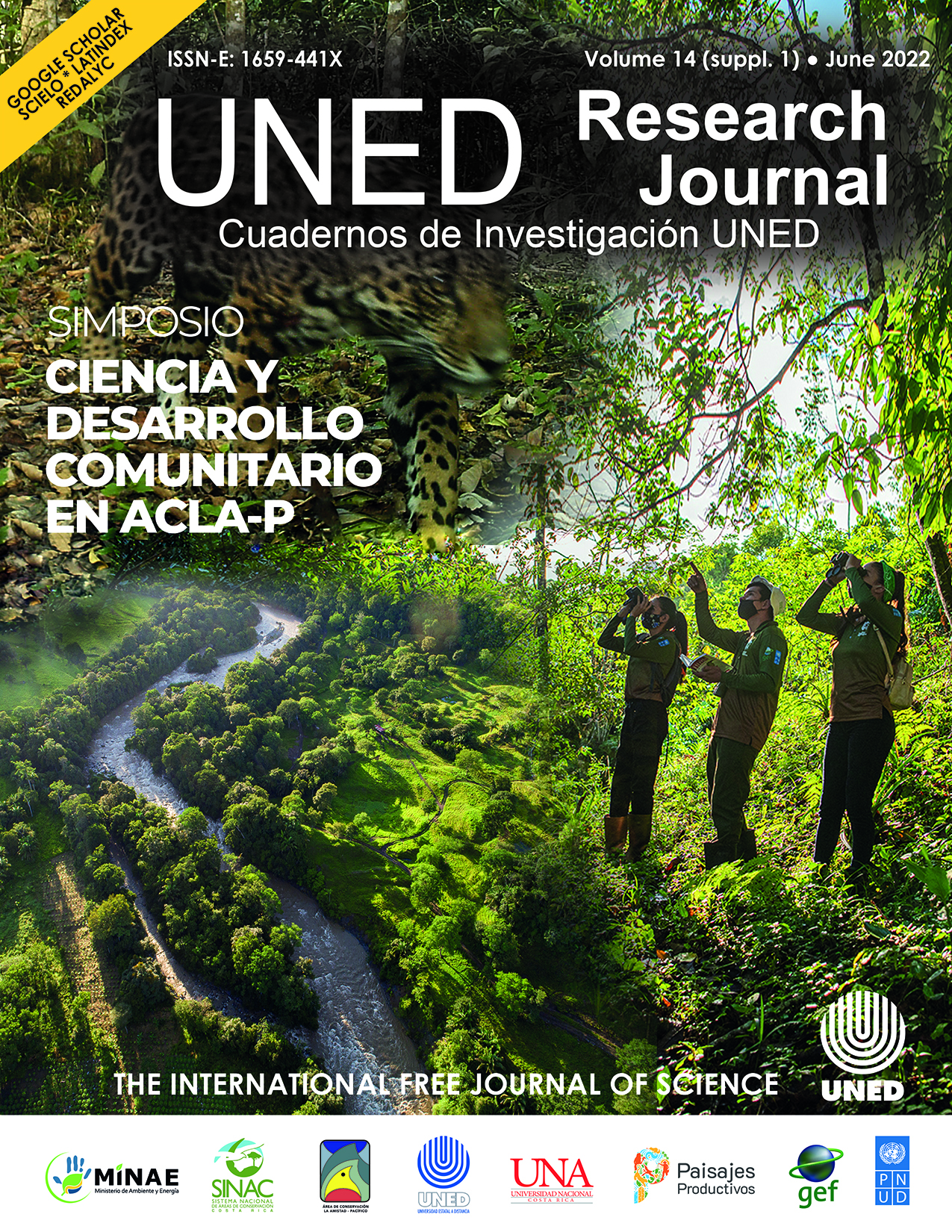Nectar production in flowers visited by hummingbirds on the Cordillera de Talamanca, Costa Rica
DOI:
https://doi.org/10.22458/urj.v14iS1.3875Keywords:
specialization, association, secretion, visitation, reabsortion, quantity, qualityAbstract
Introduction: The spatial and temporal variation of the food resource in ecosystems causes discrepancies in the plant-hummingbird functional structure that affect the particular assembly roles. Objective: To evaluate the nectar production and concentration patterns in wild flowers visited by hummingbirds at several elevations over the Cordillera de Talamanca. Methods: Collection of nectar from flowers bagged with a fine mesh for 24 hours at three elevations: high, low and medium. Measurement of flower morphology for each sampled flower, taking temperature, air and soil humidity.Experiments with nectar variations. Results: There is a high variability in nectar production between species and families, associated with the presence of nectar thieves, energy saving strategy and evaporation. At low and medium elevation sites, higher altitudes had lower nectar concentrations, but flowers at higher elevations had more sugary nectar. The smaller flowers produce greater volume and greater concentration. These hummingbirds prefered sweeter nectars, and there was greater visitation at the higher elevation, which is affected by hierarchical behavior and the need for the pollinator. Conclusion: The energy resource for hummingbirds is limited by the morphological barriers between the corollas and the type of beak, the geographic reduction in nectar volume and the competition between species.
References
Avalos, G. (2019). Recomendaciones para mejorar el manejo de comederos artificiales para colibríes. Zeledonia, 23(2), 69-75. https://bit.ly/3Do4iIU
Bacon, I., Hurly, A., & Healy, S. (2010). Both the past and the present affect risk-sensitive decisions of foraging rufous hummingbirds. Behavioral Ecology, 21(1), 626–632. https://doi:10.1093/beheco/arq031
Clasen, A., Eardley, C., Hemp, A., Peters, M., Peters, R., Ssymank, A., & Steffan, I. D. (2019). Specialization of plant–pollinator interactions increases with temperature at Mt. Kilimanjaro. Ecology and Evolution, 10, 2182-2195 https://doi.org/10.1002/ece3.6056
Corbet, S. A. (2003). Nectar sugar content: estimating standing crop and secreation rate in the field. Apidologie, 34(1), 1-10. https://doi:10.1051/apido:2002049
Deliso, E. (2007). Climate Change and the Hummingbirds of the Monteverde Cloud Forest, Costa Rica (1 ed.). Centro Científico Tropical. https://bit.ly/2YSNOd0
Descamps, C., Quinet, M., Baijot, A., y Jacquemart, A. (2018). Temperature and water stress affect plant–pollinator interactions in Borago officinalis (Boraginaceae). Ecology and Evolution, 8(6), 3443-3456. https://doi.org/10.1002/ece3.3914
EPHI Ecology of Plant and Hummingbird Interactions (2021). Research and Study Approach for the project Developing the predictive ecology of plant-animal interactions across space and time. https://hummingbird.bio/study-approach/
Gómez, L. R., Ortiz-Pulido, R., & Lara, C. (2013). Sensibilidad al riesgo durante el forrajeo en los colibríes Hylocharis leucotis y Selasphorus platycercus. Revista Mexicana de Ornitología, 14(1), 7-16. https://bit.ly/3Dk7sNP
Maglianesi, M. (2016). Efectos del cambio climático sobre la polinización y la producción agrícola en América tropical. Revista Ingeniería, 26(1), 11-20. https://bit.ly/3qEXao5
Maglianesi, M., Blüthgen, N., Böhning-Gaese, K., y Schleuning. M. (2014). Morphological traits determine specialization and resource use in plant–hummingbird networks in the neotropics. Ecology, 95(12), 3325-3334. https://bit.ly/30q65PL
Márquez-Luna, U., Lara, C., & Ortiz-Pulido, R. (2017). La calidad del néctar afecta la conducta territorial y de forrajeo en hembras del colibrí lucifer (Calothorax lucifer): Un experimento. Ornitología Neotropical, 26(1), 67-75. https://core.ac.uk/reader/288303490
McDade, L. A., & Weeks, J. A. (2004). Nectar in Hummingbird-pollinated Neotropical Plants I: Patterns of Production and Variability in 12 Species. Biotropica, 36(2), 192-215. https://www.jstor.org/stable/30043108
Salinas-Esquivel, L., Arizmendi, M. del C., Domínguez, C., Castillo-Guevara, C., & Lara, C. (2013). Producción De Néctar y Flores como Rasgos Compensatorios al Robo de Néctar en Bouvardia Ternifolia (Rubiaceae): Experimentos de Campo. Botanical Sciences, 91(1), 85-92. http://www.scielo.org.mx/pdf/bs/v91n1/v91n1a7.pdf
Published
How to Cite
Issue
Section
License
Copyright (c) 2021 UNED Research Journal

This work is licensed under a Creative Commons Attribution 4.0 International License.
Note: This abstract contains an incorrect copyright due to technical issues. Authors who publish with this journal agree to the following terms: Authors retain copyright and grant the journal right of first publication with the work simultaneously licensed under a Creative Commons Attribution License that allows others to share the work with an acknowledgement of the work's authorship and initial publication in this journal
All journal contents are freely available through a CC BY 4.0 license.
CC BY 4.0 is a Creative Commons: you can copy, modify, distribute, and perform, even for commercial reasons, without asking permission, if you give appropriate credit.
Contents can be reproduced if the source and copyright are acknowledged according to the Open Access license CC BY 4.0. Self-storage in preprint servers and repositories is allowed for all versions. We encourage authors to publish raw data and data logs in public repositories and to include the links with all drafts so that reviewers and readers can consult them at any time.
The journal is financed by public funds via Universidad Estatal a Distancia and editorial independence and ethical compliance are guaranteed by the Board of Editors, UNED. We do not publish paid ads or receive funds from companies.




